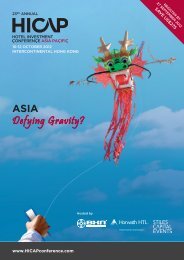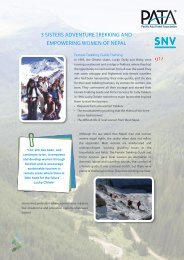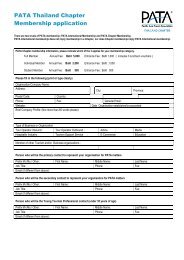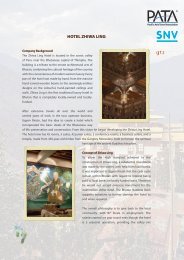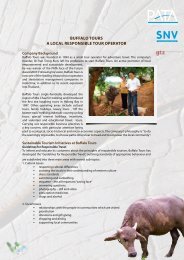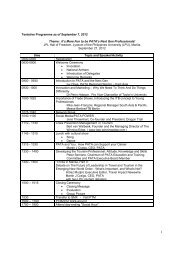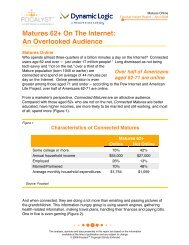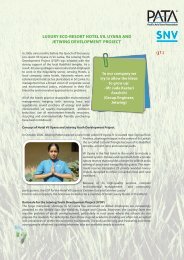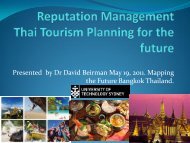PATA: 2012 Was a Record Year for Asia/Pacific Tourism
PATA: 2012 Was a Record Year for Asia/Pacific Tourism
PATA: 2012 Was a Record Year for Asia/Pacific Tourism
You also want an ePaper? Increase the reach of your titles
YUMPU automatically turns print PDFs into web optimized ePapers that Google loves.
<strong>PATA</strong>: <strong>2012</strong> <strong>Was</strong> a <strong>Record</strong> <strong>Year</strong> <strong>for</strong> <strong>Asia</strong>/<strong>Pacific</strong> <strong>Tourism</strong><br />
March 7, 2013, BANGKOK: <strong>Asia</strong> and the <strong>Pacific</strong> continued as a hot spot <strong>for</strong> international tourism in<br />
<strong>2012</strong>, attracting what is expected to be in excess of 350 million international visitor arrivals, expanding<br />
its collective inbound count by more than 5% and generating more than 18 million additional <strong>for</strong>eign<br />
visits, year-on-year. This is according to preliminary results released today by the <strong>Pacific</strong> <strong>Asia</strong> Travel<br />
Association (<strong>PATA</strong>).<br />
This is the third consecutive year in which <strong>for</strong>eign arrivals growth has remained positive <strong>for</strong> the region.<br />
Of the 40 separate destinations covered, only five reported contractions <strong>for</strong> the year. Most of those<br />
were relatively marginal <strong>for</strong> the region as a whole. The only exception was China, which, with a<br />
contraction in growth of 2.2%, is estimated to have lost around three million international arrivals<br />
(<strong>for</strong>eign and compatriot) from its 2011 total international inbound count.<br />
The picture is quite different <strong>for</strong> <strong>for</strong>eign arrivals to China however (i.e. excluding compatriot arrivals).<br />
The year <strong>2012</strong> saw an increase of 1.6% in that inbound volume, year-on-year.<br />
Southeast <strong>Asia</strong> was the strongest per<strong>for</strong>mer in <strong>2012</strong> in annual percentage growth terms, with a gain<br />
of 9.9% <strong>for</strong> the year. This equated to an increase of more than eight million additional arrivals over the<br />
previous year and pushed the ASEAN aggregate international inbound count to almost 89 million.<br />
Within this sub-region, Myanmar had a staggering increase of almost 52% in arrivals, while Cambodia<br />
and Lao PDR reported gains of 24% and 22% respectively. All three destinations created new records<br />
with Myanmar breaking the million arrivals mark (in total) <strong>for</strong> the first time. Cambodia and Lao PDR<br />
both also broke the three million mark. They were not alone either as every destination within the<br />
ASEAN region set new highs in terms of international arrivals.<br />
After several years of strong double-digit growth rates, South <strong>Asia</strong> is now settling back somewhat,<br />
but still returning strong gains; <strong>2012</strong> <strong>for</strong> example saw growth of 6.6% and an increase of well over<br />
half-a-million additional international arrivals. Sri Lanka, with growth of almost 18% saw its <strong>for</strong>eign<br />
arrivals count pass the one million mark, while the Maldives fell just short of it. India remains the titan<br />
within South <strong>Asia</strong> however, with more than 6.6 million arrivals and a year-on-year gain of close to<br />
340,000 additional <strong>for</strong>eign arrivals, some 59% of the total additional increase in the arrivals volume to<br />
the sub-region.<br />
Even with the contraction in total international arrivals into China, Northeast <strong>Asia</strong> still maintained a<br />
growth rate of almost 4% <strong>for</strong> the year. It dominated the visitor increase count by receiving close to 8.5<br />
million additional international arrivals year-on-year.<br />
Japan turned in the strongest percentage growth with a gain of 35% <strong>for</strong> the year, a per<strong>for</strong>mance that<br />
saw the destination recoup the losses in visitor arrivals following the tsunami of 2011 and move once<br />
again into record arrivals territory. Chinese Taipei, Hong Kong SAR and Korea (ROK) also added to<br />
the sub-regional per<strong>for</strong>mance with growth increases of 20%, 16% and 14% respectively.<br />
After a somewhat mediocre per<strong>for</strong>mance in 2011 (+0.3% growth), the <strong>Pacific</strong> bounced back strongly<br />
in <strong>2012</strong> to post a collective gain across eighteen destinations of 6%. This in turn equated to an<br />
increase of better than 1.1 million additional international arrivals to the sub-region, which now<br />
collectively boasts an international inbound volume tantalisingly close to 20 million.<br />
The Northern Marianas (+17.4%), Vanuatu (15.1%) and Guam (+12.8%) reported the strongest<br />
percentage gains, while Hawaii, Australia and Guam posted the greatest gains in additional arrivals<br />
<strong>for</strong> the year.<br />
/more follows,
Across the <strong>Asia</strong>/<strong>Pacific</strong> region, preliminary figures suggest that the top five destinations, by growth in<br />
international visitor arrivals, were: Myanmar, Japan, Cambodia, Lao PDR and Chinese Taipei; each<br />
had a year-on-year increase of 20% or better.<br />
In volume terms, there were six particularly significant outcomes with Hong Kong SAR, Thailand,<br />
Japan, Singapore, Korea (ROK) and Chinese Taipei each securing in excess of one million additional<br />
arrivals in <strong>2012</strong>; the SAR of Hong Kong saw 6.7 million additional international arrivals.<br />
Martin J Craigs, CEO of <strong>PATA</strong>, said: “<strong>Asia</strong> and the <strong>Pacific</strong> continues to add substantially to the global<br />
international arrivals count. We expect that to continue <strong>for</strong> some time yet. The players shift and<br />
change of course and we can expect some movement in terms of generating and receiving markets.<br />
But across the region we expect substantial gains in both the volume and the value of these<br />
movements <strong>for</strong> some time yet.”<br />
The <strong>PATA</strong> CEO added: “How we measure and determine the impacts of this growth in traffic is<br />
becoming more important, however. That is why <strong>PATA</strong> is working to promote the concept of the<br />
Complete Visitor Economy throughout its membership and across the wider industry”.<br />
20%<br />
<strong>Asia</strong>/<strong>Pacific</strong> international visitor arrivals (IVAs) trends:<br />
Monthly change, year-on-year (%), Jan-10 to Dec-12<br />
Source: relevant NTOs/NSAs; compiled by <strong>PATA</strong><br />
15%<br />
IVAs % change (y-o-y)<br />
10%<br />
5%<br />
0%<br />
-5%<br />
-10%<br />
Jan-10<br />
Feb-10<br />
Mar-10<br />
Apr-10<br />
May-10<br />
Jun-10<br />
Jul-10<br />
Aug-10<br />
Sep-10<br />
Oct-10<br />
Nov-10<br />
Dec-10<br />
Jan-11<br />
Feb-11<br />
Mar-11<br />
Apr-11<br />
May-11<br />
Jun-11<br />
Jul-11<br />
Aug-11<br />
Sep-11<br />
Oct-11<br />
Nov-11<br />
Dec-11<br />
Jan-12<br />
Feb-12<br />
Mar-12<br />
Apr-12<br />
May-12<br />
Jun-12<br />
Jul-12<br />
Aug-12<br />
Sep-12<br />
Oct-12<br />
Nov-12<br />
Dec-12<br />
1 <strong>Asia</strong>/<strong>Pacific</strong> is defined as including the following sub-regions <strong>for</strong> the purposes of press releases:<br />
Northeast <strong>Asia</strong> = China, Chinese Taipei, Hong Kong SAR, Japan, Korea (ROK) and Macau SAR<br />
Southeast <strong>Asia</strong> = Cambodia, Indonesia, Lao PDR, Malaysia, Myanmar, Philippines, Singapore, Thailand and Vietnam<br />
South <strong>Asia</strong> = Bhutan, India, Maldives, Nepal, Pakistan and Sri Lanka<br />
The <strong>Pacific</strong> = Australia, Cook Islands, Fiji, Guam, Hawaii, Kiribati, Marshall Islands, New Caledonia, New Zealand, Niue,<br />
Northern Marianas, Palau, Papua New Guinea, Samoa, Tahiti, Tonga, Tuvalu and Vanuatu<br />
Results are preliminary; estimates are used <strong>for</strong> missing data. All comparative figures are year-on-year unless otherwise stated.<br />
For more market trends and insights, please visit http://mpower.pata.org/<br />
For back issues, please visit www.pata.org/Intelligence
-ENDS-<br />
Media Contact:<br />
Parita Niemwongse<br />
<strong>PATA</strong> Communications,<br />
Bangkok, Thailand.<br />
Tel: +66 2 658 2000<br />
E-mail: communications@<strong>PATA</strong>.org<br />
Online newsroom: www.<strong>PATA</strong>.org/Press<br />
Follow <strong>PATA</strong> on Twitter and Facebook<br />
Prepared by:<br />
<strong>PATA</strong>’s Strategic Intelligence Centre (SIC)<br />
About <strong>PATA</strong><br />
Since its foundation in 1951, the <strong>Pacific</strong> <strong>Asia</strong> Travel Association (<strong>PATA</strong>), a not-<strong>for</strong> profit membership association, has achieved<br />
international acclaim by acting as a catalyst <strong>for</strong> the responsible development of travel and tourism to, from and within the <strong>Asia</strong><br />
<strong>Pacific</strong> region.<br />
The Association provides aligned advocacy, leadership and events to its members, comprising 90 government, state and city<br />
tourism bodies, nearly 30 international airlines, airports and cruise lines, 57 educational institutions, and hundreds of travel<br />
industry companies in <strong>Asia</strong> <strong>Pacific</strong> and beyond.<br />
Thousands of travel professionals belong to dozens of local <strong>PATA</strong> chapters worldwide. The chapters organise travel industry<br />
training and business development events. <strong>PATA</strong>’s ‘Next Generation’ mPOWER plat<strong>for</strong>m delivers unrivalled data, <strong>for</strong>ecasts and<br />
insights from the <strong>PATA</strong> Strategic Intelligence Centre to members’ mobile devices anywhere in the world. <strong>PATA</strong>’s headquarters<br />
is in Bangkok.<br />
Please visit www.<strong>PATA</strong>.org. Please follow us @




